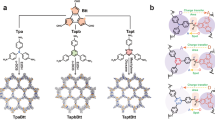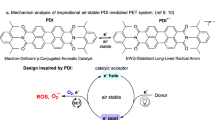Abstract
An artificial [FeFe]-hydrogenase ([FeFe]-H2ase) mimic 3II, consisting of dual organic chromophores covalently assembled to the [Fe2S2] active site, was constructed for light-driven hydrogen evolution. The structural conformation of synthetic photocatalyst was characterized crystallographically and spectroscopically. The photo-induced intramolecular electron transfer was evidently demonstrated by the combination of electrochemical, steady-state, and transient absorption spectroscopic studies. Finally, a remarkable activity was obtained in the present photocatalytic system, indicating the covalent incorporation of photosensitizer and catalytic center as a promising strategy to construct inexpensive, easily accessible [FeFe]-H2ase model photocatalysts.








Similar content being viewed by others
References
Adams MWW, Stiefel EI (1998) Biological hydrogen production: not so elementary. Science 282(5395):1842–1843. doi:10.1126/science.282.5395.1842
Artero V, Berggren G, Atta M, Caserta G, Roy S, Pecqueur L, Fontecave M (2015) From enzyme maturation to synthetic chemistry: the case of hydrogenases. Acc Chem Res 48(8):2380–2387. doi:10.1021/acs.accounts.5b00157
Baskaran D, Mays JW, Zhang XP, Bratcher MS (2005) Carbon nanotubes with covalently linked porphyrin antennae: photoinduced electron transfer. J Am Chem Soc 127(19):6916–6917. doi:10.1021/ja0508222
Bogan LE, Lesch DA, Rauchfuss TB (1983) Synthesis of heterometallic cluster compounds from Fe3(μ3-Te)2(CO)9 and comparisons with analogous sulfide clusters. J Organomet Chem 250(1):429–438. doi:10.1016/0022-328X(83)85067-0
Borg SJ, Bergamini T, Best SP, Razavet M, Liu X, Pickett CJ (2004) Electron transfer at a dithiolate-bridged diiron assembly: electrocatalytic hydrogen evolution. J Am Chem Soc 126(51):16988–16999. doi:10.1021/ja045281f
Cammack R (1999) Bioinorganic chemistry: hydrogenase sophistication. Nature 397:214–215. doi:10.1038/16601
Capon JF, Gloaguen F, Petillon FY, Schollhammer P, Talarmin J (2009) Electron and proton transfers at diiron dithiolate sites relevant to the catalysis of proton reduction by the [FeFe]-hydrogenases. Coord Chem Rev 253(9–10):1476–1494. doi:10.1016/j.ccr.2008.10.020
Chong D, Georgakaki IP, Mejia-Rodriguez R, Sanabria-Chinchilla J, Soriaga MP, Darensbourg MY (2003) Electrocatalysis of hydrogen production by active site analogues of the iron hydrogenase enzyme: structure/function relationships. Dalton Trans 32(21):4158–4163. doi:10.1039/B304283A
Crouthers DJ, Ding S, Denny JA, Bethel RD, Hsieh CH, Hall MB, Darensbourg MY (2015) A Reduced 2Fe2S Cluster Probe Of Sulfur–Hydrogen Versus Sulfur–Gold Interactions. Angew Chem Int Ed 54(38):11102–11106. doi:10.1002/anie.201504574
Darensbourg MY, Lyon EJ, Zhao X, Georgakaki IP (2003) The organometallic active site of [Fe] hydrogenase: Models and entatic states. Proc Natl Acad Sci USA 100(7):3683–3688. doi:10.1073/pnas.0536955100
Denny JA, Darensbourg MY (2015) Metallodithiolates as ligands in coordination, bioinorganic, and organometallic chemistry. Chem Rev 115(11):5248–5273. doi:10.1021/cr500659u
Eilers G, Schwartz L, Stein M, Zampella G, De Gioia L, Ott S, Lomoth R (2007) Ligand versus metal protonation of an iron hydrogenase active site mimic. Chem Eur J 13(25):7075–7084. doi:10.1002/chem.200700019
Felton GAN, Mebi CA, Petro BJ, Vannucci AK, Evans DH, Glass RS, Lichtenberger DL (2009) Review of electrochemical studies of complexes containing the Fe2S2 core characteristic of [FeFe]-hydrogenases including catalysis by these complexes of the reduction of acids to form dihydrogen. J Organomet Chem 694(17):2681–2699. doi:10.1016/j.jorganchem.2009.03.017
Gao S, Huang S, Duan Q, Hou JH, Jiang DY, Liang QC, Zhao JX (2014) Iron–iron hydrogenase active subunit covalently linking to organic chromophore for light-driven hydrogen evolution. Int J Hydrog Energy 39(20):10434–10444. doi:10.1016/j.ijhydene.2014.05.003
Georgakaki IP, Thomson LM, Lyon EJ, Hall MB, Darensbourg MY (2003) Fundamental properties of small molecule models of Fe-only hydrogenase: computations relative to the definition of an entatic state in the active site. Coord Chem Rev 238–239:255–266. doi:10.1016/S0010-8545(02)00326-0
Gloaguen F, Rauchfuss TB (2009) Small molecule mimics of hydrogenases: hydrides and redox. Chem Soc Rev 38:100–108. doi:10.1039/B801796B
Goy R, Apfel U, Elleouet C, Escudero D, Elstner M, Görls H, Talarmin J, Schollhammer P, González L, Weigand W (2013) A silicon-heteroaromatic system as photosensitizer for light-driven hydrogen production by hydrogenase mimics. Eur J Inorg Chem 2013(25):4466–4472. doi:10.1002/ejic.201300537
Heinekey DM (2009) Hydrogenase enzymes: recent structural studies and active site models. J Organomet Chem 694(17):2671–2680. doi:10.1016/j.jorganchem.2009.03.047
Iijima T, Momotake A, Shinohara Y, Sato T, Nishimura Y, Arai T (2010) Excited-state intramolecular proton transfer of naphthalene-fused 2-(2′-Hydroxyaryl)benzazole family. J Phys Chem A 114(4):1603–1609. doi:10.1021/jp904370t
King RB (1962) Organosulfur derivatives of metal carbonyls. i. the isolation of two isomeric products in the reaction of triiron dodecacarbonyl with dimethyl disulfide. J Am Chem Soc 84(12):2460. doi:10.1021/ja00871a045
Kluwer AM, Kapre R, Hartl F, Lutz M, Spek AL, Brouwer AM, van Leeuwen PWNM, Reek JNH (2009) Self-assembled biomimetic [2Fe2S]-hydrogenase based photocatalyst for molecular hydrogen evolution. Proc Natl Acad Sci USA 106(26):10460–10465. doi:10.1073/pnas.0809666106
Lomoth R, Ott S (2009) Introducing a dark reaction to photochemistry: photocatalytic hydrogen from [FeFe] hydrogenase active site model complexes. Dalton Trans 38:9952–9959. doi:10.1039/B911129H
Lubitz W, Reijerse E, van Gastel M (2007) [NiFe] and [FeFe] hydrogenases studied by advanced magnetic resonance techniques. Chem Rev 107(10):4331–4365. doi:10.1021/cr050186q
Lubitz W, Ogata H, Rüdiger O, Reijerse E (2014) Hydrogenases. Chem Rev 114(8):4081–4148. doi:10.1021/cr4005814
Na Y, Pan JX, Wang M, Sun LC (2007) Intermolecular electron transfer from photogenerated Ru(bpy)3+ to [2Fe2S] model complexes of the iron-only hydrogenase active site. Inorg Chem 46(10):3813–3815. doi:10.1021/ic070234k
Nicolet Y, Piras C, Legrand P, Hatchikian EC, Fontecilla-Camps JC (1999) Desulfovibrio desulfuricans iron hydrogenase: the structure shows unusual coordination to an active site Fe binuclear center. Structure 7(1):13–23. doi:10.1016/S0969-2126(99)80005-7
Nicolet Y, Lacey AL, Vernéde X, Fernandez VM, Hatchikian EC, Fontecilla-Camps JC (2001) Crystallographic and FTIR Spectroscopic Evidence of Changes in Fe Coordination upon Reduction of the Active Site of the Fe-only Hydrogenase from Desulfovibrio desulfuricans. J Am Chem Soc 123(8):1596–1601. doi:10.1021/ja0020963
Ogo S, Ichikawa K, Kishima T, Matsumoto T, Nakai H, Kusaka K, Ohhara T (2013) A functional [NiFe] hydrogenase mimic that catalyzes electron and hydride transfer from H2. Science 339(6120):682–684. doi:10.1126/science.1231345
Palmer PJ, Hall G, Trigg RB, Warrington JV (1971) Antimicrobials. 1. Benzothiazolylbenzylamines. J Med Chem 14(12):1223–1225. doi:10.1021/jm00294a024
Rauchfuss TB (2015) Diiron azadithiolates as models for the [FeFe]-hydrogenase active site and paradigm for the role of the second coordination sphere. Acc Chem Res 48(7):2107–2116. doi:10.1021/acs.accounts.5b00177
Rehm D, Weller A (1970) Kinetics of fluorescence quenching by electron and H-atom transfer. Isr J Chem 8(2):259–271. doi:10.1002/ijch.197000029
Seyferth D, Henderson RS (1981) Di-μ-thiolbis(tricarbonyliron), (μ-HS)2Fe2(CO)6: an inorganic mimic of organic thiols. J Organomet Chem 218(2):C34–C36. doi:10.1016/S0022-328X(00)86113-6
Seyferth D, Womack GB, Henderson RS, Cowie M, Hames BW (1986) Michael-type addition reactions of bis(μ-mercapto)bis(tricarbonyliron): proximity-induced formation of bidentate organosulfur ligands. Organometallics 5(8):1568–1575. doi:10.1021/om00139a010
Sheldrick GM (1996) SADABS Absorption Correction Program. University of Göffingen, Göffingen
Sheldrick GM (1997) SHELXTL 97 Program for the Refinement of Crystal Structure. University of Göffingen, Göffingen
Siemens Energy & Automation Inc, Inc Automation (1996) Software packages SMART and SAINT. Madison, Wisconsin
Tard C, Pickett CJ (2009) Structural and functional analogues of the active sites of the [Fe]-, [NiFe]-, and [FeFe]-hydrogenases. Chem Rev 109(6):2245–2274. doi:10.1021/cr800542q
Tard C, Liu XM, Ibrahim SK, Bruschi M, De Gioia L, Davies SC, Yang X, Wang LS, Sawers G, Pickett CJ (2005) Synthesis of the H-cluster framework of iron-only hydrogenase. Nature 433:610–613. doi:10.1038/nature03298
Wang WG, Wang F, Wang HY, Si G, Tung CH, Wu LZ (2010) Photocatalytic hydrogen evolution by [FeFe] hydrogenase mimics in homogeneous solution. Chem Asian J 5(8):1796–1803. doi:10.1002/asia.201000087
Wang F, Wang WG, Wang HY, Si G, Tung CH, Wu LZ (2012) Artificial photosynthetic systems based on [FeFe]-hydrogenase mimics: the road to high efficiency for light-driven hydrogen evolution. ACS Catal 2(3):407–416. doi:10.1021/cs200458b
Wang M, Han K, Zhang S, Sun LC (2015) Integration of organometallic complexes with semiconductors and other nanomaterials for photocatalytic H2 production. Coord Chem Rev 287:1–14. doi:10.1016/j.ccr.2014.12.005
Wolpher H, Borgström M, Hammarström L, Bergquist J, Sundström V, Styring S, Sun L, Åkermark B (2003) Synthesis and properties of an iron hydrogenase active site model linked to a ruthenium tris-bipyridine photosensitizer. Inorg Chem Commun 6(8):989–991. doi:10.1016/S1387-7003(03)00140-0
Wombwell C, Caputo CA, Reisner E (2015) [NiFeSe]-hydrogenase chemistry. Acc Chem Res 48(11):2858–2865. doi:10.1021/acs.accounts.5b00326
Wu LZ, Chen B, Li ZJ, Tung CH (2014) Enhancement of the efficiency of photocatalytic reduction of protons to hydrogen via molecular assembly. Acc Chem Res 47(7):2177–2185. doi:10.1021/ar500140r
Xu T, Chen D, Hu X (2015) Hydrogen-activating models of hydrogenases. Coord Chem Rev 303:32–41. doi:10.1016/j.ccr.2015.05.007
Yang P, Zhao JZ, Wu WH, Yu XR, Liu YF (2012) Accessing the longlived triplet excited states in bodipy-conjugated 2-(2-Hydroxyphenyl) benzothiazole/benzoxazoles and applications as organic triplet photosensitizers for photooxidations. J Org Chem 77(14):6166–6178. doi:10.1021/jo300943t
Zhong W, Zampella G, Li Z, De Gioia L, Liu Y, Zeng X, Luo Q, Liu XM (2008) Synthesis, characterisation of two hexa-iron clusters with Fe2S2(CO)x (x = 5 or 6) fragments and investigation into their inter-conversion. J Organomet Chem 693(25):3751–3759. doi:10.1016/j.jorganchem.2008.09.021
Acknowledgements
We are grateful to the National Natural Science Foundation of China (Nos. 21201022, 61106050, and 61473132), The Specialized Research Fund for the Doctoral Program of Higher Education (New Teachers, No. 20122216120001), and the Scientific and Technological Development Project of Jilin Province (No. 20150311086YY) for financial support.
Author information
Authors and Affiliations
Corresponding author
Rights and permissions
About this article
Cite this article
Gao, S., Zhang, WY., Duan, Q. et al. An artificial [FeFe]-hydrogenase mimic with organic chromophore-linked thiolate bridges for the photochemical production of hydrogen. Chem. Pap. 71, 617–625 (2017). https://doi.org/10.1007/s11696-016-0049-8
Received:
Accepted:
Published:
Issue Date:
DOI: https://doi.org/10.1007/s11696-016-0049-8




